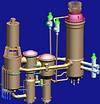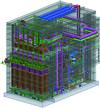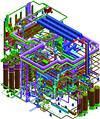Nuclear power project uses versatile CAD
1 February 2004

The South African electricity utility, Eskom, has been investigating the Pebble Bed Modular Reactor (PBMR) since 1993 as part of its Integrated Electricity Planning process.
The overall objectives of these investigations were to establish whether such a system could form part of Eskom's expansion planning, and what specific advantages it would bring over other options. These included an evaluation of the technical performance and economic merits of the project. These investigations indicated that the PBMR had major potential advantages, both to the electricity supply industry and to the overall South African economy; and that it warranted consideration as a possible option for future South African electricity supply.
In 2000, a PBMR company was formed between Eskom, the Industrial Development Corporation of South Africa (IDC), British Nuclear Fuel (BNFL) and the US utility Exelon, to build and market PBMR-based power plants. The intention is to build and operate a single module to serve as a demonstration plant and a launch platform for local and international sales. Successful completion of the demonstration will be followed by commercialisation, with Eskom likely to be the first customer.
The PBMR module is the smallest standalone component of the PBMR power generation system. The commercial models can produce approximately 165 MW of electrical power. This module can be used to generate power in a standalone mode or as part of a power plant that consists of up to 10 units.
The module consists of a pebble bed reactor that drives a closed circuit gas turbine machine. The working gas in the cycle is helium. Helium was chosen because it is chemically and radiologically inert.

UG CAD at PBMR
Currently PBMR is making use of Unigraphics CAD as well as Teamcenter software to manage large mechanical assemblies.
P & ID
At PBMR, the P & ID process is currently in its infancy, Autoplant P & ID record structures have, in a demonstration model, been incorporated together with Teamcenter. Communication between P & ID data and Teamcenter Item files has been established. The plans are to expand this demonstration method to include the entire PBMR assembly structure and to use a common database.
According to Craig Kerr, CAD Manager at PBMR, the benefits of incorporating P & ID into the module are shorter design cycle to instrumentation and electrical systems, as well as a more reliable system - due to the fact that all tags can be checked and evaluated.

Large assembly modelling
Within PBMR's drafting module, filters are used to minimise data required for creating standard views, section views and layouts. Reference sets are used in the display of plant layouts. This may often require external data only, thus a 'lite' or 'external' reference set will be used. Filters are then saved with options of 'lite' data. Additional reference sets may also be generated for interface checking and application specific requirements, for example FEM or Computational Fluid Dynamics.
As a general rule, all components are modelled parametrically, however, third party sub-systems may require translation, using parasolid, STEP or IGES. The result is a non-parametric UG model.
In addition to parametric modelling techniques, at PBMR, the unique WAVE method is used to drive 3D component positions and common data through the assembly.
Management of CAD data
According to Kerr, "UG CAD data is central to PBMR's large assembly management philosophy."
Configuration control methods and structures are easily set-up and managed within the Teamcenter environment. Teamcenter provides a flat data structure that may be viewed, but not necessary changed, by working groups and administrators.
Shortening the FEA cycle
Kerr concluded by commenting on the FEA cycle, "The (native) UG CAD file is imported into Patran, saving modelling time and assuring model integrity. Models created parametrically, within UG CAD, may then be changed, using sketches and WAVED geometry, resulting in an updated FEM model. The Create mid surface command may shorten the FEM shell element mesh times. The parasolid output exchange file is also used to interface into PBMR Patran software."
For more information on UG CAD as well as Teamcenter software contact ESTEQ Design, 012 991 9200.
For more information on the PBMR project, visit www.pbmr.co.za
Others who read this also read these articles
The high-end MCAD and cPDm market segments of the PLM strategy
CIMdata considers the high-end MCAD market to include only those few CAD solution providers that deliver very comprehensive computer-aided design and analysis capabilities that are also tightly integrated with an enterprise-capable cPDm solution from the same supplier[ December 2005 ]
SA's prototype designers awarded
The SABS Design Institute is the driving force behind design promotion in the country through various award schemes, supporting innovation and entrepreneurship[ October 2005 ]
2D to 3D: the path to better products, faster and cheaper
Modern 3D CAD systems allow designers and engineers to edit a few parameters and automatically create the downstream deliverables for unique variants in minutes, instead of days or weeks[ October 2005 ]
ECL in Africa
ECL ensures a worldwide coverage of its client base through local service units which incorporate all the ECL know-how[ August 2005 ]
Catia brings business to South Africa
The fact that the A400M contracts were awarded to local enterprises is a strategic breakthrough for the South African aerospace industry[ August 2005 ]
Strand7 analyses the Beijing Water Cube
The latest Strand7 Release 2.3 has added the capability to take site specific seismic time histories and simply create equivalent spectral curves[ June 2005 ]
Pro/E versus SolidWorks
In summary, SolidWorks' swept surfaces and solids are more limited in their capabilities than Pro/Engineer's[ June 2005 ]
Northern Railway Extension receives green light
Windhoek Consulting Engineers was appointed as consulting engineers for the Northern Railway Extension, responsible for all aspects regarding the design and construction supervision of the total project valued at N$ 1,4 billion[ April 2005 ]
Others who read this also read these news items
Digitising a standard racing engine provides a springboard for future improvements
[ December 2005 ]
Nelson Mandela Metropolitan University leads the way with Catia V5
[ December 2005 ]
Integrated CNC solution for SA tooling industry
[ December 2005 ]
Accelerated design at Donkin Fans
[ December 2005 ]
PGF transforms its vision into reality
[ December 2005 ]
Defy introduces new product range
[ October 2005 ]
New Smarts for legal eagles
[ October 2005, Cadshop ]
Vectorworks scores with architects on ease of use
[ October 2005 ]
Others who read this also read these regulars
Search Site
Subscribe
Previous Issues
Other Technews Publications
Other Technews Buyers Guides
 |  | Copyright c1995-2009 Technews Publishing (Pty) Ltd.. All rights reserved. |